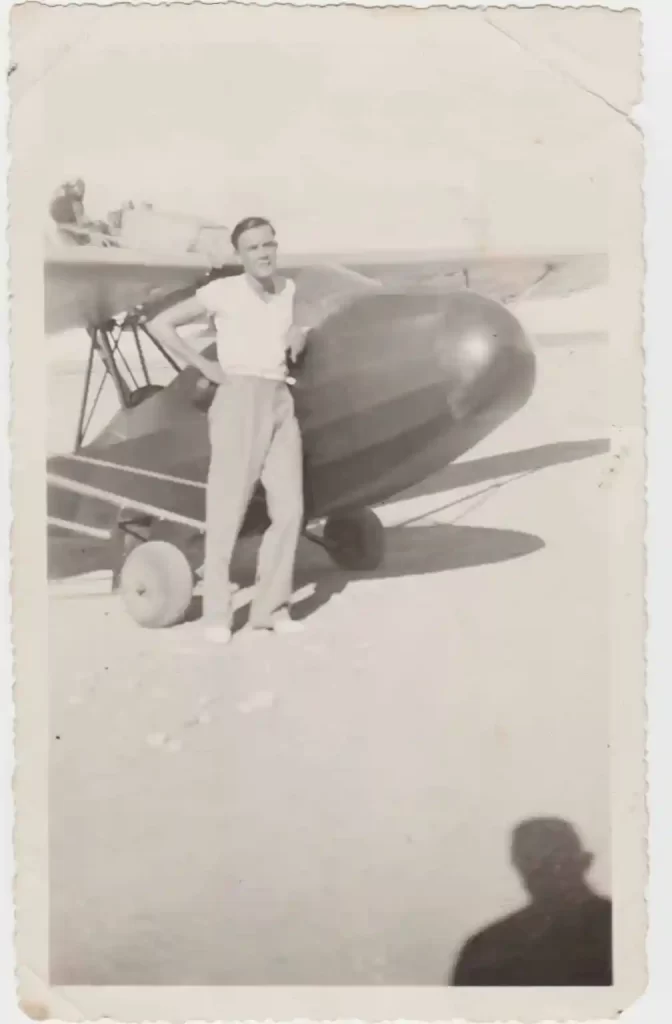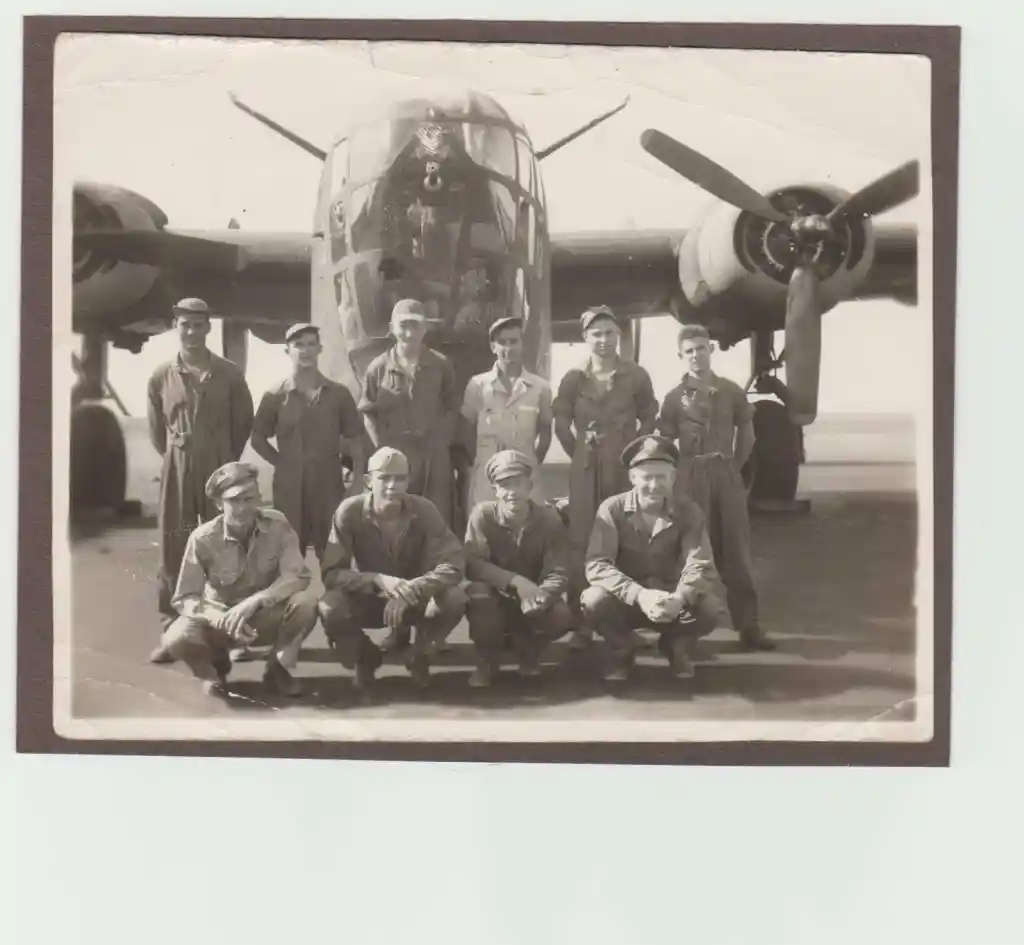The dream grew up before he did.
He was born in the high desert and mountains of West Texas into a broken family.
During the height of the Depression, he was sent off to live with distant relatives and spent his adolescence and early teen years on a 3,000-acre cattle ranch near Carrizo Springs, Texas, southwest of San Antonio and only 50 miles from the Mexican border.
He learned to ride horses, drive cattle and work hard. The type of hard work that would drop you into bed with the dying sun and demand that you rise with its return.
But somewhere planted in the outskirts of his imagination, a dream was growing. As improbable as it seemed at the time, he wanted to fly. He wanted to be a pilot.
The dream grew up before he did.
In his later teen years, he returned to West Texas, where his love for airplanes and his dreams of flying them far above the difficult world he had come to know below were consummated.
At seventeen, he was flying a 45 horsepower Curtiss-Wright Junior before graduating to various Stinson and Piper aircraft and then even heavier twin-engine aircraft. By the time he was twenty, he had become an accomplished pilot and instructor in the Southwest.

[Taken in 1936 somewhere in far West Texas, leaning against a “CW Jr” at the age of seventeen.]
With a war raging in Europe, he set his sights on the newly expanding Army Air Corps, where he had his first bitter taste of politics.
Much of the traditional Army leadership saw the role of the then Army Air Corps as strictly a means to support ground troops. At the same time, the men who would become the heroes of modern aerial warfare, such as Billy Mitchell, George Marshall, and Henry “Hap” Arnold, among others, realized that air power would be central, not peripheral, to the new world war.
However, after enlisting, he found himself assigned not to the Army Air Corps as he supposed, but, rather, the expert horseman was placed in the U.S. Army Cavalry. (Yes, the U.S. still had a horse cavalry at the start of World War II!) Finally, he finagled a spot with the new Army Air Force, created by Congress in 1941. (His “finagling” behind the backs of his superiors resulted in him spending the last 30 days of his Cavalry career shoveling horse manure in the stables before his transfer was effective.)
The seasoned private pilot excelled in his heavy aircraft training in Sweetwater, Texas, and then he himself became a four-engine flight instructor until November 10, 1943.
That’s the date when the then Second Lieutenant left Hamilton Field, California, with orders to report to the 13TH Air Service Command in Espiritu Santo, in the New Hebrides, piloting a B-24-J four-engine heavy bomber with a crew of nine.
(The B-24 was the most sophisticated long-range bomber in the early 1940s, although not as nimble as its better-known predecessor, the B-17. It flew at nearly 300 MPH, with four 1,200 horsepower Pratt and Whitney turbocharged radial engines, and had a combat range of 2,000 miles. Weighing in at 65,000 pounds fully loaded, the Liberator could carry 8,000 pounds of bombs and ten .50 caliber machine guns in its mechanized gun turrets.)
His orders stated that he and his crew would travel “via Hickam [Hawaii], Christmas, Tutuila, Nandi, thence to Espiritu Santo.” (The largest island in what is today the nation of Vanuatu in the South Pacific, 6,000 miles from California and 2,200 miles from Australia.)

[Undated photo somewhere in the Pacific. Second from the left bottom. ]
He would receive the first of ten Oak-Leaf Clusters (Air Medal) for an attack on the Rabaul area of New Britain in what was described as “dangerous flying weather [with] skillful flying and navigation…he successfully accomplished his mission in the face of frequent anti-aircraft fire.”
In 1944 he would receive his fourth Oak-Leaf Cluster Air Medal, reading in part, “for meritorious achievement…in sustained operational flight missions in the Southwest Pacific…against enemy airdromes and installations and attacks on enemy naval vessels and shipping.”
He would soon be promoted to Captain, serving, as the order noted, “in addition to his other duties, Assistant Operation Officer.” Then he would serve as the Operations Officer and Group and Squadron Commander as a Major.
He was twenty-six years old.
After nearly two years in the Pacific Theater, he was sent home, having flown 58 missions over places that sound so unimportant now, seven decades past. But in 1944 and 1945, they were the pathway – the necessary stepping stones – to the full-out assault on the Japanese homeland: Kahili, Vanakanau, Rabaul, Guadalcanal, Truk, Yap, Palau, Borneo, and Luzon, to name only a few.
Those 58 missions consisted of 695 combat hours, and 33 of the missions were flown as the squadron commander. In addition to the Air Medal with ten Oak-Leaf Clusters, he would be awarded the Philippine Liberation Ribbon with Star, the Asiatic Pacific Ribbon with nine battle stars, and a purple heart.
My father, Major Henry J. Giere, was an American hero in every sense of the word.
Over the years, I’ve written many articles about Memorial Day and Veterans Day. I’ve written about individual heroes, interviewed American combat wounded veterans at Walter Reed National Military Medical Center, and about personal friends killed in action in Vietnam.
In the past, I’ve asked on Memorial Day, are we worthy of their sacrifice?
But this year is different. May 15, this year, marked the 105th anniversary of my father’s life. I found it most appropriate to share his story and his legacy as a combat pilot and American patriot.
His story didn’t end with the war. He was recalled to active duty in 1947 as a Major. He served the nation again through the early 1950s as an air intelligence officer in England and Germany, where operational control of the new nuclear arsenal was critical to keep the hard-won peace.
He continued to fly after his twelve years of military service. He held every air certification possible; as an instructor, instrument ratings, up to an Airline Transport Pilot rating. Indeed, for several years, he owned a small regional airline and flew routes to and from small towns across West Texas, New Mexico, and Arizona.
During the Vietnam War, a group of former Air Force pilots was recruited to fly – to “ferry” – the famous “02” Cessna observation and close support twin-engine aircraft that was used by the Air Force, Army, and Navy, from the factory in Wichita Kansas, hop-skipping across the Pacific Ocean all the way to Da Nang Air Base in Vietnam. The weeklong trip was dangerous flying.
On July 24, 1969, he flew his last “mission.” He was killed while delivering his umpteenth “O2” aircraft. With nearly 20,000 hours of flying time, his last day arrived far too soon; he was only fifty-one.
You will not find the name of Major Henry J. Giere on the Vietnam Memorial wall. But I see his name there nonetheless, every time I visit.
A hero among heroes.
[This Article first appeared in 2018.]

